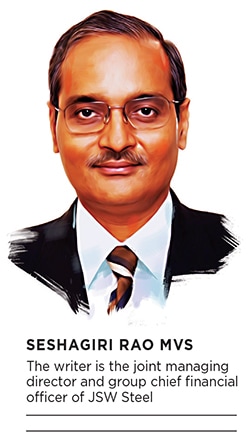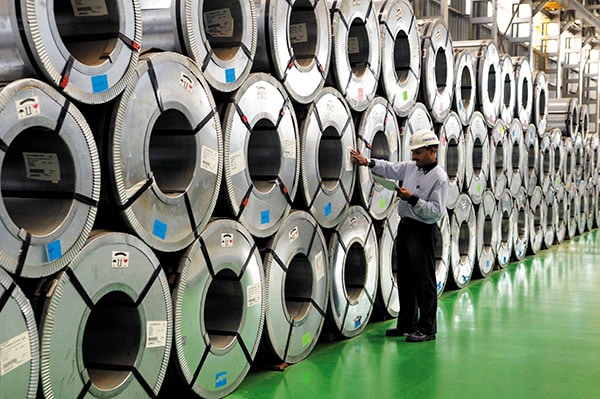
The steel industry needs handholding, not protection: Seshagiri Rao MVS
Budget 2016 should propose remedial measures to ensure that domestic steel producers are shielded from unbridled imports at unfair prices
 If the government’s ambitious Make in India programme is to succeed and if India has to become a manufacturing hub, the steelmaking sector will have to play a crucial role. However, for that to happen, the domestic steel industry needs to be protected from the trade imbalance caused by steel imports at unfair prices.
If the government’s ambitious Make in India programme is to succeed and if India has to become a manufacturing hub, the steelmaking sector will have to play a crucial role. However, for that to happen, the domestic steel industry needs to be protected from the trade imbalance caused by steel imports at unfair prices.
The government’s recent decision to impose a minimum import price on steel imports is a welcome step for the industry. The government had earlier imposed a safeguard duty on imports and also enforced a quality order to prevent inferior steel from entering the country. But these measures were only imposed on limited grades of steel and were ineffective in countering rampant imports. This time, the minimum import price has been made applicable to 173 (out of 343) grades of steel that account for 80 percent of all steel imports. This will make it a far more effective step.
In the upcoming budget, the government would do well to propose some remedial measures to prepare a level-playing field for Indian steel producers, who are key stakeholders in its plan to ramp up infrastructure-creation and facilitate long-term economic growth.
India is the third-largest steel producer in the world after China and Japan and also the third-largest consumer of steel after China and the US. It is also the largest producer of sponge iron. The country has exported over 80 million tonnes of steel since 1991, competing with the same set of countries that are now dumping steel in India at predatory prices. This is adversely affecting the domestic industry. Unbridled imports from countries like Japan, South Korea and China are causing irreparable damage to the industry, despite the fact that we are the second-most competitive steel industry in the world.
Some of the global factors that have led to the current situation include severe contraction in steel demand in China due to a steep decline in construction, housing and infrastructure investments; falling investments in mining, metals and oil and gas due to a sharp fall in commodity prices; rapid deterioration of emerging economies like Brazil and Russia accentuated by the strength of the dollar; and free trade agreements signed by India with Japan, South Korea and others to allow steel imports at negligible to zero percent duty.
All these have led to a structural oversupply in the world market with Japan and South Korea offering high discounts on their domestic prices.
Major listed Chinese steel companies had a heavy operating loss burden in 2015. But, instead of cutting back on production, China, with the support of export subsidies and rebates from the government, increased steel exports to compensate for the fall in domestic demand.
The steel industry is characterised by high capital intensity, dependency on bulk raw materials like iron ore and coal and the cyclicality of commodities and geopolitical factors. In view of the complex problems faced by the sector and its strategic importance for nation building, this industry always requires government handholding.
When exports from China, Japan and South Korea surged, several trade remedial measures were initiated (441 interventions) by various countries across the world. When the imports of finished steel into India grew by 71 percent in 2014-15 and 30 percent in the current fiscal, the Indian steel industry sought the government’s intervention to arrest the dumping.
After liberalisation in 1991, large investments of over Rs 5 lakh crore have been made to increase the installed capacity of steel production in India from 13 million tonnes in 1991 to 114 million tonnes at present with state-of-the-art facilities and technologies capable of producing advanced steel grades. Though the installed capacity is expected to reach 124 million tonnes by the end of FY2015-16, capacity utilisation has gone below 80 percent. Around 15 percent of domestic steel demand is being met through imports even as domestic capacity is lying idle.

Capacity utilisation in India’s steel industry is below 80 percent
Steel as an industry is capital- and labour-intensive. Lower capacity utilisation pushes up fixed and capital servicing costs, severely impacting viability. When steel prices fell, the domestic industry was deprived of the competitive advantage of lower iron ore prices as regulatory action led to a shortage of raw material and kept prices high.
Furthermore, lower oil prices haven’t resulted in lower freight rates in India. Railway freight rates went up by over 25 percent in the last two years, adding to the woes of the industry. Cost of capital for steelmakers in India is also higher compared to their peers globally.
What the industry needs is a level playing field to correct these imbalances, and not protection per se, as is perceived generally.
China, Japan and South Korea will continue to export steel into India as these exports are strategic for them to protect jobs and investments in their countries, but the Indian steel industry, which is the backbone for industrial development, will not remain viable if imports are allowed to continue at unfair prices. If the current status quo stands, India may have to permanently rely on steel imports.
In this light, the government should consider a few proposals in the budget. These include: Increase in import tariffs, initiate action to impose safeguards in the form of anti-dumping and countervailing duties on the import of steel products into the country; issue quality orders to comply with regulations laid down by the Bureau of Indian Standards; impose non-tariff barriers; exclude steel from free trade agreements; provide concessions on railway freight rates on a capital-intensive industry like steel; auction iron ore and coking coal mines by earmarking them to existing companies in the steel sector; increase duty drawback to compensate fully non-modvatable taxes; and provide access to capital at competitive rates.
Steel demand is driven by growth in the infrastructure, transportation, capital goods and packaging sectors. The recent amendment to the Mines and Minerals (Development and Regulation) Act has given a fillip to the mining sector, creating demand for earth moving equipment and commercial vehicles. The proposed investment of Rs 8.5 lakh crore in railways, and plans to create renewable energy capacity to the tune of 175 gigawatts as well as to increase outlays on public expenditure augur well for steel demand.
It is, thus, of paramount importance to initiate remedial measures to correct the trade imbalance that exists in the steel sector and ensure the viability of this industry.
(This story appears in the 30 November, -0001 issue of Forbes India. To visit our Archives, click here.)




